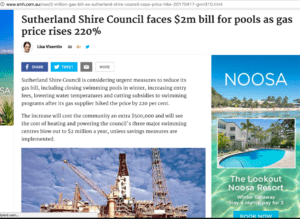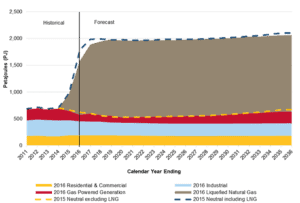Our council was in the spotlight this week with a story in the Sydney Morning Herald that the gas bills for our aquatic centers have risen 220% to $2 million per annum. See story below:

So, what’s happening?
Australia has abundant supplies of gas. Drilling and mining of Bass Strait between Victoria and Tasmania started in 1965, and was underwritten by a 40-year gas contract with the Victorian Government, which included providing gas pipes to households throughout Greater Melbourne and other regions.
The supply of gas has spread across the Eastern seaboard to more dense areas and industrial zones in SA, NSW and Queensland through large interstate gas pipelines, and used for electricity generation, industrial processes and home and business heating and cooking. In addition to Bass Strait, more gas mining in NSW and Queensland, and more recently more Coal Seam Gas mining.
In 2010, Santos got approval for construction of the $60 billion Gladstone LNG export facility, and after 6 years of construction and commissioning, it commenced exporting gas in 2016. The premise was to make the most of our abundant gas resources in Australia to get export revenues.
What does this mean?
Typically gas was sold locally at $4 per Gigajoule (GJ) wholesale in Australia. In addition to this charge, customers pay gas network and retail charges. This means a large customer pays around $6/GJ and a small household $16/GJ.
However, gas can be sold for $11/GJ on the global market, to other countries like Japan. The cost of converting methane gas into liquid gas at Gladstone, and shipping overseas is around $3 per GJ, so the net price local gas producers can get from Gladstone is $8 per GJ.
And the Gladstone LNG export facility…well…it’s really big. It can export almost double the amount of gas annually we historically used. See graph below from AEMO:

The brown part of the graph is the new ‘demand’ for gas at the Gladstone export facility. This means if a gas producer can sell gas for $8 per GJ to Gladstone, then they won’t want to provide it any cheaper to local Victoria, NSW, SA or Queensland customers. It also means that local gas production has to increase significantly to meet demand. And this is not happening at the rate needed, so now sometimes it is even hard for businesses to find a gas supplier, and costs are going up well beyond the $8 per GJ.
What can we do?
There are some are calling for more gas mining to meet this new demand. Others are calling for a local reserve of gas for local use.
But there are better options: switch off gas!
For households, you can switch from gas to better options:
- Cooking – Switch to induction cooktops
- Heating – Use your Reverse Cycle Air Conditioner and get insulation, rather than a gas burner
- Hot Water – Get a heat pump or Solar Thermal Hot Water system
The beauty of these options is they are electric, so can be supplied by a rooftop solar system or from renewable energy in the electricity grid. And while many are used to gas heaters and appliances, and are fearful of the change, electric really is better.
Watch for more stories on gas and renewable solutions. Or get in touch for more information. We’d love to hear from you: info@sunnyshire.org.au
And what can the council do? Watch this space.

